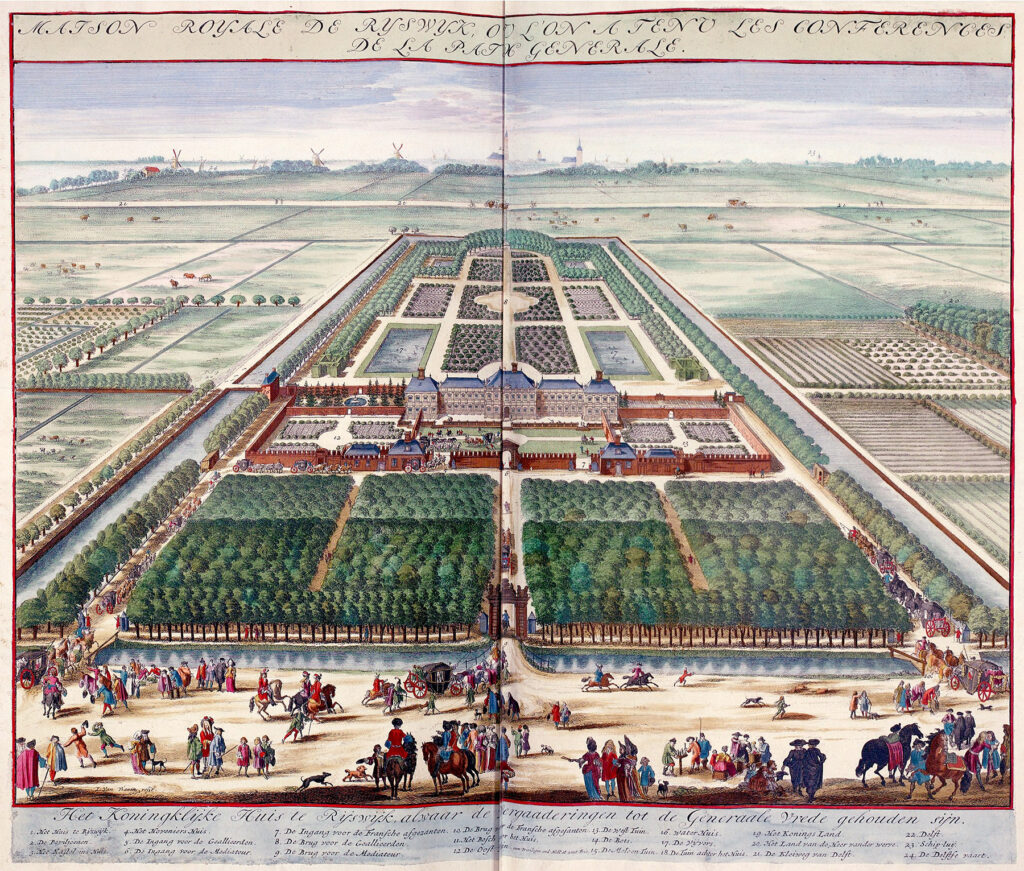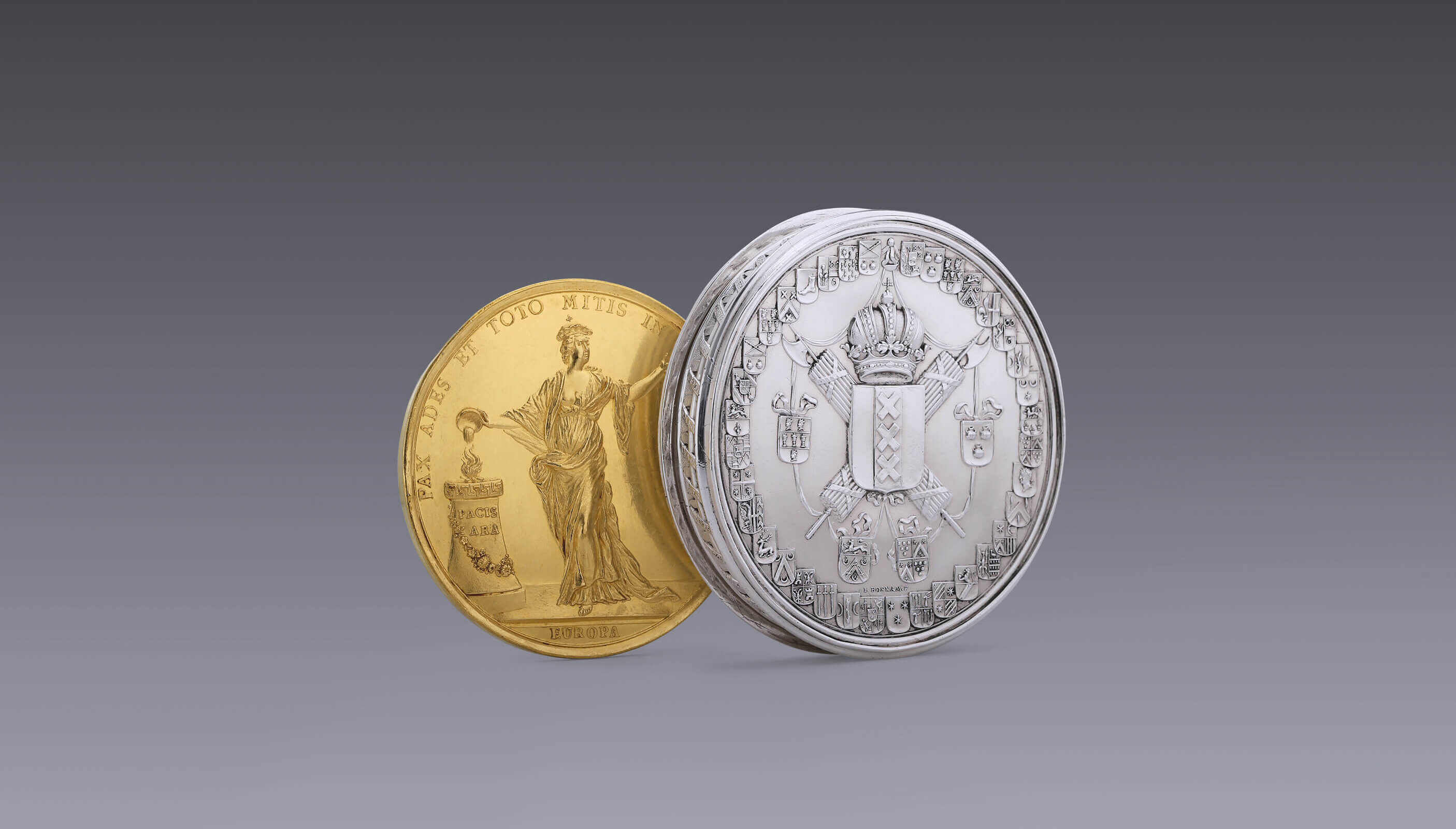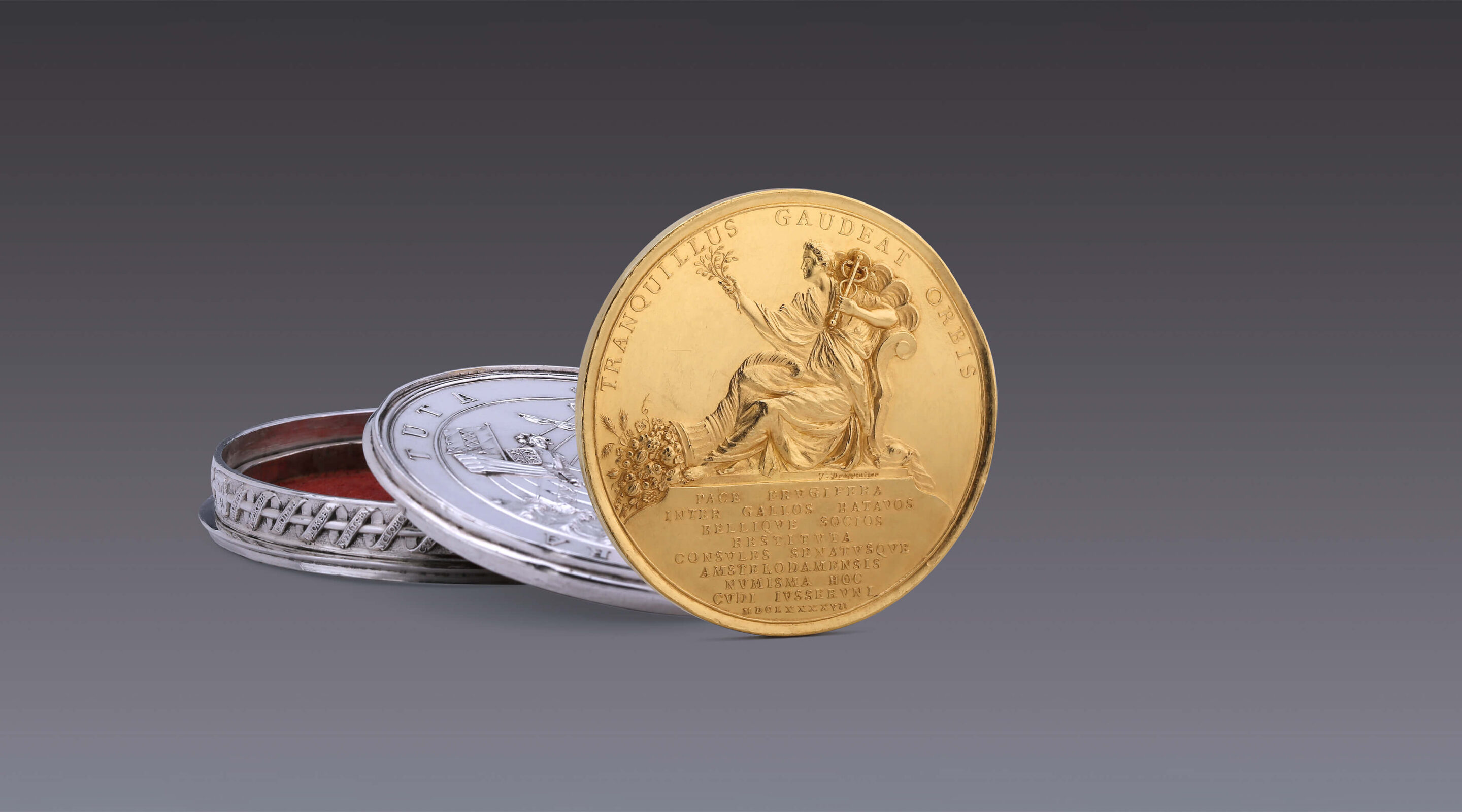This important gold medal with its accompanying beautifully executed silver box, was made in 1697 on the occasion of the signing of the Peace of Rijswijk that year. Of the thirty-six of medals that were made, only five are known nowadays, of which this is one. This medal was made by Josias Drappentier, who made it to a design by Daniel de Lange. The original die is now in the Amsterdam Museum Collection. The accompanying silver box was made by the silversmith and medallist Jan Boskam.
The Peace of Ryswick Medal
Gold
There are many known antique medals made in silver. Gold medals, however, are much rarer, particularly ones of this size. This has to do mainly with the value of gold. Around 1700, gold was some fifteen times more expensive than silver. This exceptionally large gold medal weighs an extraordinary 185 grams. At that time a silver guilder weighed ten grams, which means that at the time the gold alone in this medal had a value of 277,5 guilders, an amount which was well over an average annual salary.
The Peace of Ryswick
The Peace of Ryswick, was a series of treaties signed in the Dutch city of Rijswijk on 20 September 1697. They ended the 1688 to 1697 Nine Years' War between France and the Grand Alliance, which included the Dutch Republic and the Holy Roman Empire. As usual, the agreement reached after the peace negotiations was named after the location where it was signed. In this case it was Ryswick, now Rijswijk, near The Hague.
Stadholder’s Palace
The negotiations took place in Huis ter Nieuwburg, the palace of William III, who was also king of England, Ireland and Scotland in this period. The palace was therefore sometimes called the Court at Rijswijk. The negotiations dragged on for months, bogged down most of all in the arguments about diplomatic protocol. A major source of conflict was the order in which the delegations would drive in their coaches along the sandy road to the palace and the use of the single access bridge. Protocol demanded that none of the parties would be favoured over another. As a compromise it was decided to build two new access gates and bridges, so that all delegations involved could arrive simultaneously. Changes were also made to the hall in which the peace discussions were held. All the chairs were placed in a circle and the table was removed so that no one could sit at its head.

Numismatic Art
The medal (Latin: denarius) was originally a type of coin and legal tender that was accepted in many European countries from the early Middle Ages onwards. The medal as a memorial or record of history arose during the Italian Renaissance. In the Netherlands commemorative medals were made since the early sixteenth century. In the seventeenth century, the Dutch Golden Age, numismatic art took off. The Republic prevailed on the world’s seas and many special medals were made to mark memorable moments in the Eighty Years’ War. The medals were made not only by the silversmiths and goldsmiths registered with the guild, but also by medallists, diecutters, engravers and coin makers. Even though they worked with gold and silver, the latter did not have to be registered with the guild. They were usually commissioned by the ‘lofty members of the States-General’, who met in The Hague and decided who deserved to receive a ‘present from the State’ in the name of the Republic.
A Present to Oneself
One might expect that this medal, too, for such an important historic event, would have been given as a present from the State to the delegation that represented the Republic of the Seven United Provinces at the negotiations. That was not, however, the case. The city of Amsterdam was powerful and very prosperous thanks to flourishing trade, and the city councillors conducted themselves in a manner to reflect the city’s stature. The thirty-six council members, of whom only Jacob Boreel was part of the delegation, consequently decided that a large gold medal should be made for this historically important event. And not a single medal, but thirty-six, so that all the councillors could present one to themselves.
The Gold Medal
One side of this heavy medal bears the female personification of Europe. In her right hand she holds a dish in which she brings a thank offering to the altar of peace: PACIS ARA. The circumscription reads ‘PAX ADES ET TOTO MITIS IN ORBE MANE’ (Come, peace, stay quietly in the whole world).
The personification of Peace appears on the other side. She sits on a throne on a pedestal, holding an olive branch in her right hand and a caduceus in the left. The Horn of Plenty lies at her feet as a sign of prosperity. The circumscription reads: ‘TRANQUILLUS GAUDEAT ORBIS’ (a tranquil world can rejoice). The inscription on the base reads ’PACE FRVGIFERA INTER GALLOS BATAVOS BELLIQUE SOCIOS RESTITVTA CONSULES SENATVSQUE AMSTELLODAMENSIS NUMISMA HOC CVDI LVSSERVNI MDCL XXXXVII’. (After the fruitful peace between the French, the Dutch and their allies in war was restored, the burgomasters and city council of Amsterdam had this medal made, 1697).
The Silver Box
A gold medal as precious as this could not simply be handed over to the recipients. In the same year, the medallist Jan Boskam made a special silver box for it lined with red velvet. The design on the box is highly detailed, showing the Amsterdam coat of arms, three St Andrews crosses topped with the imperial crown. Carrying the imperial crown above the coat of arms was a gift from the Austrian emperor Maximilian by way of thanks for the financial support that the city had lent the Austrian and Burgundian rulers during the Hook and Cod Wars. Around the arms is a ribbon from which hang the coats of arms of Johannes Hudde, Joan Korver, François de Vicq and Jacob Boreel, the four burgomasters who held sway in 1697, the last of whom was a member of the Republic’s delegation for the negotiations. Their escutcheons are bound to two fasces as symbols of their high office. On the outer edge are the arms of the other thirty-two Amsterdam councillors. The raised side of the box has a continuous banderole all round in high relief, bearing the thirty-six names of the serving councillors. The names are given in the same order as the escutcheons on the lid. On the other side is the old Amsterdam coat of arms, the cog with two soldiers, the dog and the flags. The circumscription reads ‘TUTA TENET ÆQUORA’ (it keeps the sea safe).
Daniel de Lange
The image on this medal was designed by Daniel de Lange (1665-1734). Born in Gouda, he was the son of the Gouda regent Cornelis de Lange (1629-1682) and Maria Elsevier (1638-1691). When he left the grammar school, he studied law at Leiden. On completing his studies, De Lange moved to The Hague, where he began working as advocate at the Court of Holland. In his free time, he engaged in chemistry, history, genealogy and numismatics. At that time it was customary for cities and districts to cast commemorative medals on the occasion of historic events. We know that De Lange corresponded on numismatic questions with the most renowned coin specialists of the age such as Gerard van Loon, Cornelis van Alkemade and his son-in-law Pieter van der Schelling. De Lange designed several images for commemorative medals after the Peace of Rijswijk, one for the city of Gouda, one for the city of Dordrecht and one for the city of Amsterdam, which were all executed by Josias Drappentier.
Josias Drappentier
Several generations of Drappentiers were involved in the making of coins and medals. In 1671 Daniel Drappentier was appointed ‘engraver general’ of Holland and West Friesland and soon afterwards of Zeeland and Utrecht too. It was a post in which he was responsible for the stamps used to strike coins and medals. The signature J:Drappentier on this medal is almost always attributed to Johannes Drappentier. However, Johannes was baptized on 13 January 1689 and was eight years old when this medal was made. It is therefore more likely that the medal was made by Josias Drappentier. In 1675 he followed Abraham Goverts as the diecutter at the Mint in Middelburg. The following year Josias was replaced there and remained as assistant engraver until 1678. There is no record of how or when his career progressed, but in 1697 he was evidently working in Amsterdam, where he was commissioned by the Magistrate to make this medal.
Jan Boskam
Jan or Johannes Boskam, who was active from 1687 to 1709, made the silver box in which the gold medal is kept. He was a medallist who originally came from Nijmegen and was working in Amsterdam until 1708. He was one of the most important diecutters at the end of the seventeenth century and has an extensive oeuvre to his name.
Provenance
Jacques Schulman NV, Amsterdam 1964
Private collection Netherlands
Literature
Catalogue XVIe Kunst en Antiekbeurs, Delft 1964, Jacques Schulman stand no. 26
P.J. Klapwijk, F. Kuyvenhoven, Historiemedals ter gelegenheid van de Vrede van Rijswijk (1697), Antiek, May 1989, pp. 545-50

This site is protected by reCAPTCHA and the Google Privacy Policy and Terms of Service apply.

